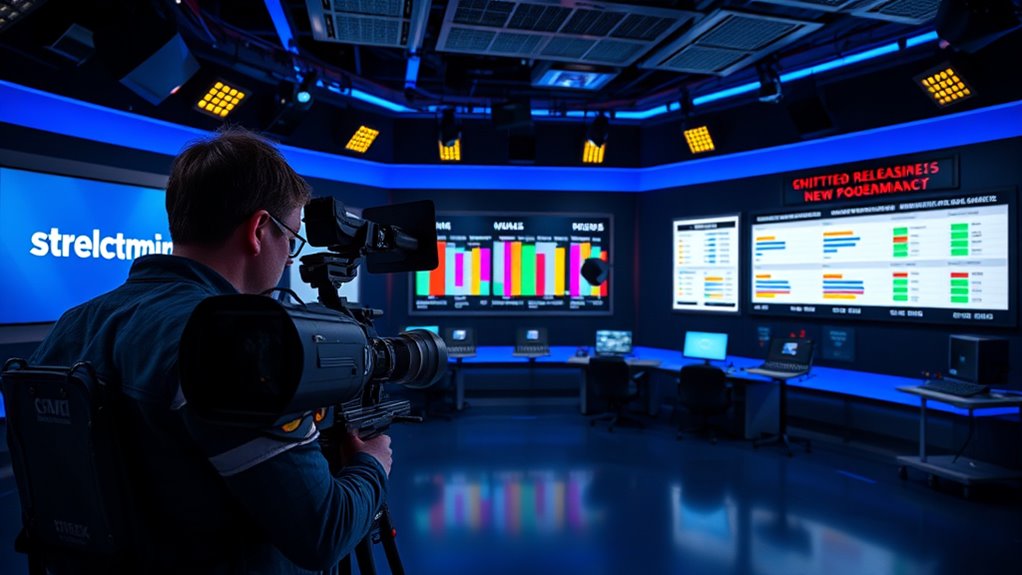Streaming has shifted TV production away from traditional pilot seasons and fixed schedules. Instead of waiting for seasonal launches, content now drops year-round, with binge releases and instant access favored by viewers. This change means networks and creators focus more on data-driven decisions and flexible strategies. If you want to understand how this new landscape affects content, advertising, and audience habits, there’s more to explore below.
Key Takeaways
- Traditional pilot season is declining as content launches occur year-round, reducing reliance on fixed testing windows.
- Streaming enables continuous content release, shifting focus from seasonal premieres to ongoing programming strategies.
- Audience binge-watching and on-demand viewing diminish the importance of traditional TV schedules and pilot testing.
- Data-driven insights allow streaming platforms to customize content and advertising, reducing the need for early pilot assessments.
- Networks are adapting by expanding digital offerings and hybrid models to stay relevant amid changing viewer habits.
The Decline of Traditional Pilot Season and Its New Dynamics

The traditional pilot season, once confined to January through April, is rapidly losing its relevance as streaming platforms disrupt the industry. You’re no longer bound by rigid windows for testing new shows; instead, content launches happen year-round. This shift means networks and studios can release pilots or full-series without waiting for specific seasons, giving them more flexibility to respond to audience preferences and data insights. Consequently, the focus moves away from a limited window of pilot testing toward continuous content development. Viewers now expect instant access to new shows at any time, making the old model of waiting for fall premieres less appealing. Streaming’s dynamic approach reshapes how creators plan, produce, and release content, fundamentally changing the traditional TV production cycle.
How Streaming Reshapes TV Programming and Release Strategies

Streaming platforms have revolutionized how TV networks and creators approach programming and release schedules. Instead of waiting for seasonal windows, they release content throughout the year, allowing for more flexible scheduling. Binge releases and full-season drops are now common, shifting focus from weekly episodes to immediate viewer engagement. Data analytics and audience demand heavily influence commissioning decisions, reducing reliance on traditional pilot testing. This approach enables creators to respond quickly to trends and preferences, often testing new concepts with minimal upfront investment. It also encourages experimentation with formats and genres, maximizing viewer retention and satisfaction. Additionally, the influence of advanced projection technology allows viewers to enjoy high-quality content in diverse environments, further changing how and when TV shows are launched and consumed.
Shifting Audience Behaviors and Demographics in a Streaming Era

As viewers increasingly turn to on-demand content, their habits and preferences are shifting markedly. You’re likely binge-watching entire series instead of waiting week-to-week, especially among younger audiences. Streaming’s flexibility allows you to watch whenever and wherever you want, making traditional TV schedules less relevant. This shift has caused a decline in live viewership, particularly among kids and teens, who now prefer quick, engaging content accessible on mobile devices. Meanwhile, older audiences tend to stick with traditional TV, maintaining more consistent viewing patterns. Younger demographics also change their viewing based on school calendars and social activities, not seasonal TV cycles. This evolving behavior influences content creation, marketing strategies, and how networks target their audiences in an increasingly fragmented media landscape. Additionally, sustainable energy practices can play a role in supporting the infrastructure that enables streaming services to operate efficiently and sustainably.
The Evolving Advertising Landscape and Monetization Opportunities

With audiences shifting toward on-demand, binge-watching content whenever they want, advertisers must rethink their strategies for reaching viewers. The changing landscape offers new monetization opportunities, especially with streaming platforms expanding ad-supported models. Here’s how you can adapt:
- Leverage data analytics to target specific segments more effectively, increasing ad relevance.
- Invest in FAST channels and other ad-supported streaming options to reach broader audiences without subscription barriers.
- Optimize campaign timing across seasons, recognizing that viewers now engage year-round rather than during traditional advertising peaks.
- Consider the impact of Vetted – Mad Tasting on content consumption patterns, which influence viewer engagement and ad effectiveness.
This evolution challenges traditional seasonal ad cycles, encouraging you to develop flexible, data-driven campaigns that maximize engagement and ROI in a more fluid viewing environment.
Implications for Traditional Networks and Future Content Delivery

Traditional networks face mounting challenges as audience habits shift and content consumption becomes more fragmented. You need to adapt by expanding your digital presence and offering flexible viewing options. Rigid schedules and fixed premiere dates no longer attract the modern viewer, who prefers on-demand binge-watching. To stay relevant, you must develop hybrid models that combine traditional broadcasts with streaming platforms, allowing for broader reach and real-time engagement. Investing in original content tailored for digital consumption can help rebuild audience loyalty. Additionally, you should leverage data analytics to understand viewer preferences and optimize content delivery. Incorporating insights from best practices for streaming content, such as personalized recommendations and interactive features, can further enhance viewer engagement. As streaming continues to grow, traditional networks must rethink their strategies, balancing live broadcasts with on-demand offerings to meet evolving expectations and remain competitive in the future media landscape.
Frequently Asked Questions
How Do Streaming Platforms Decide Which Shows to Develop Without Pilot Testing?
You’re likely to see streaming platforms use data analytics and audience demand to decide which shows to develop, rather than traditional pilot testing. They analyze viewer preferences, engagement metrics, and social trends to predict a show’s potential success. This approach allows for faster decisions, less risk, and the ability to instantly release full seasons if a concept resonates, making the process more flexible and audience-driven.
What Are the Long-Term Effects of Year-Round Content Release on Viewer Engagement?
Year-round content release keeps viewers hooked like a roller coaster, creating continuous engagement. You find yourself binge-watching without waiting for seasonal drops, which deepens your connection to streaming platforms. This steady stream of new shows and episodes prevents boredom and builds loyalty. Over time, you’ll notice your attention spans adapt, and traditional TV’s once predictable rhythm loses its grip, making your viewing habits more spontaneous and personalized.
How Is Audience Measurement Evolving With the Integration of Linear and Streaming Data?
You’ll notice audience measurement now combines linear and streaming data to get a fuller picture of viewer habits. Instead of relying solely on traditional ratings, you’ll see cross-platform metrics that track on-demand, binge-watching, and live viewing. This integrated approach allows advertisers and content creators to better understand engagement patterns, optimize campaigns, and make data-driven decisions that reflect how audiences consume content across multiple screens and platforms in real time.
Will Traditional TV Networks Fully Transition to Streaming or Maintain Hybrid Models?
You’ll see traditional TV networks adopt hybrid models rather than fully shifting to streaming. Streaming now accounts for nearly 45% of TV viewing, but networks still rely on live sports and news to reach audiences. They’re launching their own streaming platforms, yet keep traditional channels alive for loyal viewers. This balanced approach lets them capture new digital audiences while maintaining their established viewer base, ensuring they stay relevant in a changing media landscape.
How Are Advertising Strategies Adapting to the Absence of Seasonal Viewership Patterns?
You should know that advertising strategies now focus on continuous, data-driven campaigns rather than seasonal peaks. With streaming’s year-round content, you can run ads anytime, targeting specific audiences more precisely. Many advertisers shift budgets to ad-supported streaming platforms and FAST channels, reducing reliance on traditional seasonal advertising. This approach allows for more flexibility, better measurement, and reaching viewers whenever they’re most engaged, regardless of the time of year.
Conclusion
As streaming continues to reshape the TV landscape, you need to stay flexible and adapt to these changing tides. The traditional pilot season is fading, replaced by on-demand releases that keep viewers hooked. It’s clear that those who embrace these shifts won’t be caught flat-footed. The key is to stay ahead of the curve—otherwise, you risk being left behind in this fast-moving world. Keep your eyes open, and you’ll find new opportunities waiting around every corner.










